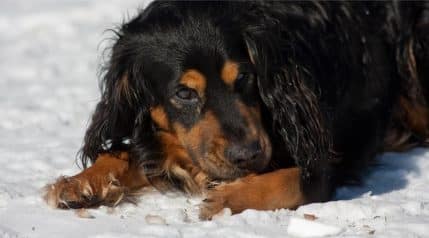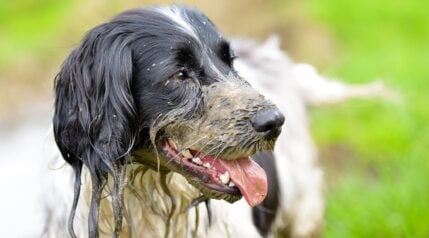Curious about how much Corgis shed? Both the Welsh Pembroke Corgis and Cardigan Corgis are double-coated pups, which means you can expect a fair amount of Corgi shedding if you welcome one into your home. Corgis are famous for leaving pieces of fur all over your clothes and furniture. However, don’t let that deter you from owning one unless you have a dog allergy. Their shedding can be managed with regular maintenance and grooming.
The Pembroke & Cardigan Welsh Corgis are similar to each other, both originating from different locations in the UK. They are smaller dogs but have thicker & shorter coats. Corgis can also have long hair. Their coats are double-coated, which means there’s a thinner layer of fur underneath their primary fur layer.
If you have a dog allergy, we’d recommend looking at a hypoallergenic dog breed. While no breeds are truly hypoallergenic, there are breeds that can be easier on those with allergies. Corgis shed, but just how much? Let’s dive into a little more detail about what you can expect if you bring one of these lovable pups into your home.
At A Glance: Best Products For Corgi Grooming

Brush For Shedding
Hartz Double-Sided

Comb For Matting
Fine-toothed Comb

Gloves For Baths
HandsOn Gloves
Note: Clicking the above links takes you to each company’s website to learn more and get a quote. If you make a purchase, we earn a commission at no additional cost to you.
Corgi Coats
Both Welsh Pembroke and Cardigan Corgis generally have medium-length coats. They can also be slightly longer, depending on their genetics. Welsh Pembroke Corgis are the more likely of the two to have long hair. A Corgis double coat means that they have a thicker and coarser top layer of fur, with a softer, dense second layer underneath. Double-coated dogs almost always shed more. Just ask any Labrador Retriever owner how much they shed.
Both types of Corgis shed year-round. This means you’ll want to take several things into account when selecting a Corgi, including the color of their coats. The primary difference in coat color between the two is that the Cardigan can carry a brindle coat and a blue merle coat. The Welsh Pembroke will not.
Coat color matters when it comes to shedding. If your Corgi has a coat that matches your floors or furniture, shedding becomes less noticeable. While there are things you can do to manage your Corgi’s shedding, having the right coat color can go a long way when it comes to visible dog hair around your home.
Corgi Shedding Frequency

Corgis are year-round shedders, and they shed their coats in some form daily. They shed more frequently in the summer and in the winter. This is common with all double-coated breeds. Most Corgis have medium-length coats, and their hair will be less visible than a Border Collie, which carries a longer coat. If your Corgi does have a longer coat, you’ll need to be more vigilant about grooming them every week.
Because Corgis shed daily, this isn’t a breed we’d recommend if you aren’t home often. They need attention, and daily grooming is recommended. At a minimum, you should be grooming your Corgi about 3 times per week. This will help make sure that unwanted hair can routinely be kept under control, keeping it away from both furniture and clothing.
When Do Corgis Shed?
Corgis shed daily. But as we’ve mentioned, there are two shedding seasons per year when the Corgi tends to shed more frequently than at other times of the year. That’s during the summer and winter months. When Corgis shed in the summer and winter, it’s referred to as “blowing their coat.” This happens in the winter when their bodies grow a thicker coat to keep them warmer in the winter. Then, during the summertime, the opposite happens in order to keep them cool.
During these two times a year, staying on top of your Corgi’s grooming habits becomes essential. You’ll want to make sure you have daily brushing sessions (3 times per week minimum) and have a good de-shedder tool on hand. You may even want to consider an anti-shedding shampoo if your Corgi’s hair becomes too difficult to manage routinely.
Shedding Triggers

Outside of the shedding season, when Corgis shed their coat more excessively, there are other shedding triggers. These are events that may take place in which your Corgi will shed more frequently. Some of them are easier to manage, but each event should be taken into consideration. If your Corgi isn’t acting as they normally would, it’s always important to visit your veterinarian to determine the root cause. Here are some common shedding triggers that may cause excess shedding.
- Skin allergies: If your Corgi is allergic to grass or other irritants, they may shed more frequently.
- Nutrition: Improper nutrition can cause your Corgi to shed more than normal.
- Stress: Stress like moving to a new home or changing surroundings can cause fur loss.
- Health: If your Corgi has a health or skin condition like atopic dermatitis, this can cause shedding.
- Bathing: Too much bathing can cause Corgis to shed their coats.
- Shampoo: Using the wrong shampoo can contribute to skin conditions and skin allergies.
While all of these common triggers can’t be entirely avoided, keeping your eye on your Corgi can help identify why shedding frequency may have increased. Stress in your dog’s routine is sometimes unavoidable. But routine grooming maintenance can help with most shedding triggers your pup may experience.
You can also try an allergy test with your dog to help determine what might be a trigger.
Managing Your Corgi’s Shedding

While you’ll never truly eliminate the fact your Corgi sheds, you can definitely manage it. Making sure you have a regular brushing routine and a proper diet are two important factors. Bathing your Corgi regularly will also help, as will having a de-shedder. You can also turn to anti-shed shampoos and other supplements to help keep hair away.
If routine maintenance doesn’t truly help your Corgi, we recommend taking a trip to your vet. But in most cases, routine grooming and a proper diet will help do the trick.
Brushing
Brushing your Corgi consistently is the single thing that can make a bigger difference when it comes to excessive shedding and loose hair. You’ll want to find the right brush and then brush your dog at least 3 times per week at a minimum. During the heavier shedding months, it’s recommended that you brush your Corgi daily. This can be done with a bristle brush or a pin-style brush. Anything less than 3 times per week will likely mean your Corgi is going to be dropping some hair around your house, on your floors, and on your clothes.
Shampoos
Most Corgis don’t deal with sensitive skin too often. Even so, we’d recommend looking at a natural dog shampoo so you don’t use something with chemicals likely to irritate your Corgi’s skin. If your Corgi sheds profusely, then an anti-shed dog shampoo can be used. Don’t exceed the bathing guidelines provided by the manufacturer. This is important. If you overbathe your dog, it can cause skin irritation and lead to additional shedding. It can also lead to a trip to the vet if the skin condition becomes painful. Bathing your dog once per month is usually sufficient.
Diet
Ensuring your Corgi eats a nutrient-dense dog food that’s high in Omega fatty acids is essential for skin and coat health. Food is the one area you don’t want to “save” money on if you don’t have to. Your pup will flourish if their dry kibble has the vitamins and nutrients they need to stay strong & healthy.
Dry kibbles that are rich in Omega Fatty acids will keep their coats smooth and their skin soft. It makes brushing and grooming your Corgi far easier in the long run. Budget is always important when owning a dog, but we’d recommend saving in other areas to ensure your Corgi has the nutrition they need for a healthy coat.
Supplements
There are plenty of chewable supplements on the market that are specifically formulated for skin and coat health. You can also leverage them as a training reward. If your Corgi is a picky eater, then you can always get a liquid form supplement and add it to your dog’s dry kibble. Supplements are great in a pinch and are great for a variety of reasons. But if you have to choose between overall food quality and buying supplements, we’d advise you to buy the best dog food you can buy to ensure your Corgi’s coat and skin health is your top priority.
Deshedding Products
As a Corgi owner, having a de-shedder in your arsenal is a must. While these tools aren’t really needed as much for low-shed breeds like Goldendoodles, they are essential when it comes to double-coated breeds that shed. We recommend looking at the Furminator or Ostershedmonster as two excellent options.
Using a de-shedder during the two times per year your Corgi is more likely to blow their coat will help keep the loose hair under control. You don’t want to use a de-shedder only – use it in conjunction with a brush. If you don’t brush your dog regularly, you’ll be getting mats out of their coat when you break out the de-shedder twice per year.
Frequently Asked Questions
How much do corgis shed?
Corgis shed about as much as any double-coated breed. They are higher maintenance than any Poodle or Poodle mix but lower than a big fluffy dog like a Bernese Mountain Dog.
When does a Corgi shed its coat?
Corgis shed year-round. However, it is significantly worse in the winter and in the summertime.
How long do Corgis shed?
If you keep up with grooming, you may find that the fur isn’t too bad to deal with most of the year. Corgis always shed. There’s really never a point through the year where they won’t.
Why do Corgis shed so much?
Most double-coated dogs shed quite a bit due to the excessive hair they have compared to some other breeds. More hair means more shedding.
Do they shed more in the summer or winter?
Typically, Corgis shed more in the summer. This is the time they are getting rid of that very thick coat they’ve added to themselves in the winter to keep warm.
Final Thoughts
The bottom line is this. Yes, Corgis shed. But it’s not unmanageable. Brushing their coats daily, or at least 3 times per week, will help to keep their hair away. Having a little more hair around your home shouldn’t be the reason you don’t adopt a specific dog breed. Far more important is the breed’s temperament and size and if it fits in with your family.
If your heart is set on adopting a Corgi but you really just don’t want to deal with the dog hair, you can always use a good set of dog clippers to keep their hair nice and short. The Corgi is a family-friendly pup, and if you can dedicate a few minutes a day to brushing out their coat, you’ll end up a far happier dog owner.






Very useful information. thanks
Your article is incorrect. Wales is not in England. The Welsh Corgi comes from Wales.
You are 100% correct. We have updated it to say they are both from the UK. Thanks!